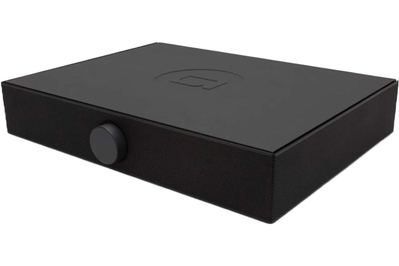Setting Up Your Turntable System Can Seem Daunting. The SpinBase Makes It Easy.

Brent Butterworth is a writer dedicated to audio gear. He has been reviewing speakers and other audio products for more than 30 years.
Imagine buying an Apple Watch and never turning it on. Or buying a professional-quality chef’s knife even though you never cook. Strange as it may seem, this behavior is normal in the world of vinyl albums, because 50% of the people who buy records have no way to play them.
Perhaps some people take sufficient joy in supporting favorite artists by buying their albums in addition to streaming them. But based on my 30-plus years of testing audio gear—as well as what I’ve heard from family, friends, and Wirecutter readers—I suspect that part of the problem is the daunting complexity of vinyl-playback systems.
Andover Audio built the SpinBase to solve this problem. The SpinBase is a one-piece speaker system that makes a turntable as easy to use as children’s record players of the 1960s and 1970s.
With a built-in phono preamp and speakers on three sides, the SpinBase makes it easy to set up a high-quality vinyl-playback system—and it supports Bluetooth, too.
Buying Options
Why the SpinBase is so easy to use
The SpinBase is a model of simplicity. This 3.25-inch-high speaker sits directly underneath your turntable and connects to it via a single cable. Just put a record on the turntable, lower the needle onto the record, and turn the SpinBase’s large, front-panel volume knob clockwise. All that vinyl that has been sitting around gathering dust and garnering admiring looks will come to life.
With turntables, hookup is usually complicated. For instance, the rig I concocted to connect my sister-in-law’s 1990s-vintage turntable to her Bluetooth speakers required two extra components (each with its own wall wart), plus two sets of cables. If we weren’t related, she might have tossed it all in the trash by now and bought herself a one-piece record player.
One reason for the complexity is the need for a phono preamp to boost and tune the turntable’s weak audio signals. Most turntables don’t come with a phono preamp, but the SpinBase has one built in, so it can connect directly to any turntable using a magnetic phono cartridge, such as the models we feature in our guide to the best turntables, or a ceramic cartridge. Only a couple of other one-piece speakers I’ve tried include this feature.
The only cable you need is one to connect the turntable to the SpinBase, and Andover Audio provides it. You can also wirelessly connect your phone, tablet, or computer to the SpinBase through Bluetooth, so you can stream from the internet when you want to listen to something you don’t yet own on vinyl.
How the SpinBase sounds
I use small, one-piece wireless speakers every day, but when I have a chance to go back to a good stereo system, it’s like going to John’s Pizzeria after a year of eating nothing but Domino’s. With a good stereo system, the sound is bigger, more spacious, and more like hearing a real band in a club or a recital at a concert hall.
When I first placed my Music Hall Ikura turntable on top of the SpinBase and dropped the needle on jazz bassist Christian McBride’s Live at the Village Vanguard, I couldn’t believe how much the SpinBase’s sound reminded me of a full stereo system.
Was I transported back to that time when I lived in Manhattan and passed countless hours in jazz’s most storied venue, listening to legendary artists I had always dreamed I would get to hear? Of course not—no audio device could replicate the excitement of being at the Vanguard, much less impose a one-drink minimum. But I was carried to a place more captivating than my suburban living room, with some sense of the Vanguard’s intimate, low-ceilinged ambience.
With most one-piece speakers, my brain works harder to translate the speaker’s unnatural, mostly monophonic sound into what I know the music is actually supposed to sound like. The SpinBase’s more realistic sound eases the workload on my ears; I get much of the same relaxing experience I get from a good stereo.
It’s not a real stereo—but it comes close

The SpinBase merely simulates a real stereo. It has speakers firing out of the left and right sides as well as the front, a design that does give it a spacious sound—for a one-piece system. It doesn’t produce the total separation of left and right sounds that you get from a stereo system that has two separate speakers. And connecting additional sources, such as a Wi-Fi audio streamer or TV set, isn’t practical.
The SpinBase also doesn’t play as loud as a good stereo. It still sounds clear even with the volume maxed out, but it’s not loud enough for anything more boisterous than a casual listening session or a dinner party.
Things you might want to add
Place the SpinBase and your turntable on any table large enough to accommodate them, or you can opt for the SpinStand, which holds the SpinBase and the turntable and provides storage for albums. The SpinStand has a headphone hook on the side, which is handy because the SpinBase has a headphone jack. (All of these components are available in white or black.)
If you crave more bass, you can add the SpinSub subwoofer, which fits in the bottom of the SpinStand and connects to the SpinBase with a supplied cable. Turn the SpinSub’s level way up if big bass is your thing, but I got better results when I set the subwoofer level to just 3 on a scale of 10; at that setting, the bass in Silk Sonic’s “Fly As Me” (video) wasn’t much louder, but it had a lot more kick and shook the floor a little, which amped up the realism even more and brought the SpinBase’s sound that much closer to what I hear from a good stereo system.
In the three months I’ve had the SpinBase, I’ve found myself playing vinyl records a lot more often—and buying more of them. With audio gear that is so simple to use and yet sounds so good, there’s no reason not to play those records you’ve been collecting. The artists would surely rather you did.
This article was edited by Annemarie Conte and Adrienne Maxwell.
Meet your guide
Brent Butterworth is a senior staff writer covering audio and musical instruments at Wirecutter. Since 1989, he has served as an editor or writer on audio-focused websites and magazines such as Home Theater, Sound & Vision, and SoundStage. He regularly gigs on double bass with various jazz groups, and his self-produced album Take2 rose as high as number three on the Roots Music Report jazz album chart.
Further reading
The Best Record Player Setup for Beginners
by Adrienne Maxwell
Start your vinyl music journey here with our picks for turntable, receiver, speakers, and more.
The Best Turntables and Record Players
by Freddy Gerngross and Brent Butterworth
The Fluance RT85N is our favorite turntable under $600 because it’s easy to set up and use, and it sounds great with all types of recordings.
How to Set Up Your Turntable to Sound Its Best
by Chris Heinonen
No matter what turntable you own, there are a few adjustments you can make—often for little to no cost—to help it sound its best.
How to Connect Your New Turntable to Any Audio System
by Brent Butterworth
No matter what kind of turntable and audio gear you have, it is possible to get them working together. Here’s how.





